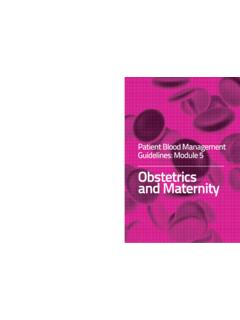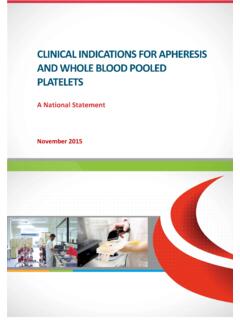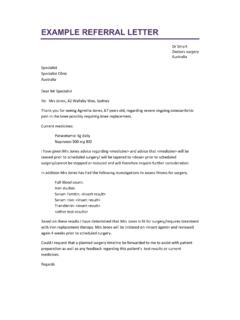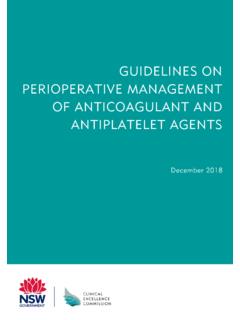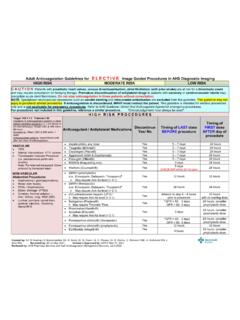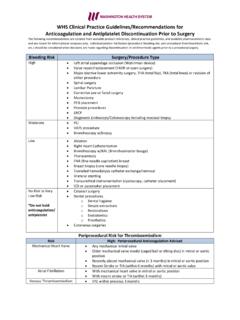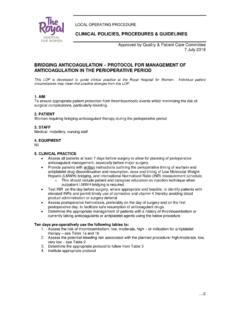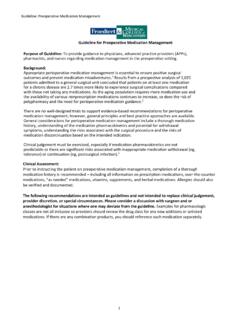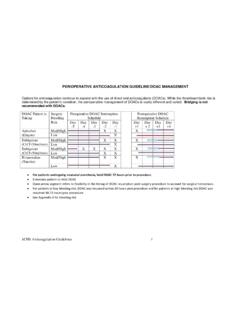Transcription of PREOPERATIVE BLEEDING RISK ASSESSMENT TOOL
1 June 2015 Guidance for Australian Health ProvidersPREOPERATIVE BLEEDING RISK ASSESSMENT TOOLWith the exception of any logos and registered trademarks, and where otherwise noted, all material presented in this document is provided under a Creative Commons Attribution Australia ( licenses/ ) licence. The details of the relevant licence conditions are available on the Creative Commons website (accessible using the links provided) as is the full legal code for the CC BY AU license ( ). The content obtained from this document or derivative of this work must be attributed as the PREOPERATIVE BLEEDING Risk ASSESSMENT . National Blood Authority, 2015. ISBN 978-0-9924971-8-7 This report is available online at: For more information: Patient Blood management National Blood Authority Locked Bag 8430 Canberra ACT 2601 Phone: 13000 BLOOD (13 000 25663) Email: NBA has commissioned the development of a suite of patient blood management (PBM) tools by various stakeholders as outlined by the PBM Guideline Implementation Strategy.
2 The tools are intended to be used as a resource for health professionals to use in implementing the recommendations and practice points in the PBM PREOPERATIVE BLEEDING Risk ASSESSMENT and Intervention Resource is intended to assist healthcare professionals in assessing and managing the risk of BLEEDING in a PREOPERATIVE patient. ASSESSMENT of BLEEDING risk is a key component of patient blood management strategies to minimise blood loss. Patients may be at increased risk of BLEEDING for a number of reasons, including hereditary or acquired BLEEDING disorders, medical conditions such as liver disease, and medications including complementary medicines. This resource was project managed by the Transfusion Practice and Education Team at the Blood BLEEDING RISk ASSESSMENT JUNE BLEEDING RISk ASSESSMENT AND INTERvENTION RESOURCE: qUICk REFERENCE GUIDE> PREOPERATIVE BLEEDING RISK ASSESSMENT JUNE history: Use of medications which might affect BLEEDING eg.
3 antiplatelet agents or anticoagulants; complementary medicinesBleeding History including: Personal history of BLEEDING disorder or excessive BLEEDING Family history of BLEEDING disorder or excessive BLEEDING Comorbidities which may increase BLEEDING risk eg. bone marrow, renal or liver disorderPhysical examination: Signs of BLEEDING , eg. petechiae, purpura, ecchymoses, haematomas, Signs of increased risk of BLEEDING , eg. jaundice, splenomegaly, arthropathy, joint and skin laxityAll negativePositivePositiveEither or both PositiveNo further evaluation requiredBleeding ASSESSMENT Tool* and/or referral to appropriate specialistAspirinNSAIDsComplementary medsWarfarin - minor proceduresWarfarinClopidogrelNew oral anticoagulantsDual antiplatelettherapyManage as per evidence based guidelinesMultidisciplinary ASSESSMENT and/or refer to specialist guidelines * Clinical Practice Guideline on the Evaluation and management of von Willebrand Disease (VWD).
4 Quick Reference. American Society of Hematology, 2012. PREOPERATIVE BLEEDING RISk ASSESSMENT AND INTERvENTION RESOURCE: qUICk REFERENCE GUIDE SUMMARYA ssessing and managing the risk of BLEEDING in a PREOPERATIVE patient can be achieved by following the key steps:1. Review medications, including complementary therapies: Manage as per evidence based guidelines , including specialist guidelines , local protocols or referral where appropriate;2. Perform initial BLEEDING history including personal and family history of BLEEDING disorder or excessive BLEEDING ; and comorbidities which may increase BLEEDING risk: If positive use a BLEEDING ASSESSMENT Tool (BAT) consisting of a standardised BLEEDING questionnaire and BLEEDING score and/or refer for further ASSESSMENT ; 3. Perform a physical examination: If positive for signs of BLEEDING or comorbidities associated with increased risk of BLEEDING use a BAT and/or refer for further ASSESSMENT ;4.
5 If all initial screens are negative, no further evaluation is required routine PREOPERATIVE coagulation screening is not recommended;5. Neither PREOPERATIVE point-of-care (POC) global coagulation assays nor POC INR measurement predict BLEEDING tendency;6. Refer for specialist and/or multidisciplinary ASSESSMENT and management , patients: undergoing high risk procedures; with haemostatic abnormalities associated with comorbid illness; on multiple antiplatelet and/or anticoagulant therapy; and those with known congenital BLEEDING regarding these steps are outlined in the following pages. Considerations for incorporation of BLEEDING risk ASSESSMENT into clinical practice using clinical practice improvement (CPI) methodologies can be found in Appendix 1.> PREOPERATIVE BLEEDING RISK ASSESSMENT JUNE BLEEDING risk ASSESSMENT and intervention resource: quick reference guide.
6 3 PREOPERATIVE BLEEDING risk ASSESSMENT and intervention resource: Quick Reference Guide Summary ..4 Background ..6 Table 1: British Committee for Standards in Haematology recommendations on the ASSESSMENT of BLEEDING risk prior to surgery or invasive proceduresa ..6 Table 2: management of severe perioperative BLEEDING : guidelines from the European Society of Anaesthesiology ..7 Figure 1: PREOPERATIVE ASSESSMENT of BLEEDING risk ..7 Medication ASSESSMENT ..8 Table 3: Guidance regarding cessation of medications - Patient Blood management guidelines : Module 2 perioperative ..9 Figure 2: Suggested management of patients receiving NOAC requiring urgent 4: PREOPERATIVE interruption of new oral anticoagulants: a suggested management approach4 ..11 BLEEDING History ..11 What is a BLEEDING ASSESSMENT Tool (BAT)? ..11 What BLEEDING ASSESSMENT Tools are available? ..12 Table 5: BLEEDING ASSESSMENT Tools.
7 13 Use of BATs in the clinical setting ..14 Application of BATs in the PREOPERATIVE setting ..14 Patients with congenital BLEEDING disorders ..15 Patients with comorbidities involving haemostatic derangement ..15 Physical examination to assess BLEEDING risk ..15 Type of surgery ..16 Table 6: Type of surgery and BLEEDING risk ..16 Coagulation ASSESSMENT ..17 Point-of-care coagulation ASSESSMENT ..17 References: ..18 Appendix 1: PREOPERATIVE BLEEDING risk ASSESSMENT and intervention considerations for organisations wanting to improve clinical practice ..20 Appendix 2: Classification of evidence levels and grades of recommendations ..22 Appendix 3: European Society of Anaesthesiology (ESA) guidance regarding cessation of medications (extract)2 ..24 Table of ContentsPREOPERATIVE BLEEDING RISK ASSESSMENT JUNE > ASSESSMENT of BLEEDING risk is a key component of patient blood management strategies to minimise blood loss.
8 Patients may be at increased risk of BLEEDING for a number of reasons, including: 6advanced age1 6decreased PREOPERATIVE red blood cell volume (small body size and/or PREOPERATIVE anaemia)1 6medications affecting haemostasis including complementary medicines 6medical conditions causing haemostatic defect including both hereditary BLEEDING disorders, and acquired medical conditions such as chronic kidney or liver disease, and 6type of surgeryPreoperative ASSESSMENT of BLEEDING risk consists of administering a structured BLEEDING questionnaire which, in conjunction with physical examination, will guide laboratory testing. In the vast majority of cases a positive BLEEDING history will require referral for specialist ASSESSMENT and management . Conversely, a negative initial screen and examination may exclude patients from further evaluation. Routine coagulation screening prior to surgery or other invasive procedures to predict postoperative BLEEDING in unselected patients is not The key recommendations from the British Committee for Standards in Haematology (BCSH) guidelines on the ASSESSMENT of BLEEDING risk prior to surgery or invasive procedures,1 and from the European Society of Anaesthesiology management of severe perioperative BLEEDING : are outlined in Tables 1 and 2.
9 Figure 1 demonstrates the key components of PREOPERATIVE ASSESSMENT of BLEEDING 1: British Committee for Standards in Haematology recommendations on the ASSESSMENT of BLEEDING risk prior to surgery or invasive proceduresa1. Indiscriminate coagulation screening prior to surgery or other invasive procedures to predict postoperative BLEEDING in unselected patients is not recommended. (Grade B, Level III).2. A BLEEDING history including detail of family history, previous excessive post-traumatic or postsurgical BLEEDING and use of anti-thrombotic drugs should be taken in all patients preoperatively and prior to invasive procedures. (Grade C, Level IV). 3. If the BLEEDING history is negative, no further coagulation testing is indicated. (Grade C, Level IV). 4. If the BLEEDING history is positive or there is a clear clinical indication ( liver disease), a comprehensive ASSESSMENT , guided by the clinical features is required.
10 (Grade C, Level IV). a For classification of evidence and recommendation levels see Appendix BLEEDING RISK ASSESSMENT JUNE 2: management of severe perioperative BLEEDING : guidelines from the European Society of AnaesthesiologyEvaluation of coagulation status: We recommend the use of a structured patient interview or questionnaire before surgery or invasive procedures, which considers clinical and family BLEEDING history and detailed information on the patient s medication. 1C We recommend the use of standardised questionnaires on BLEEDING and drug history as preferable to the routine use of conventional coagulation screening tests such as a PTT, PT and platelet count in elective surgery. 1C b For grades of recommendation - GRADES system see Appendix 1: PREOPERATIVE ASSESSMENT of BLEEDING riskMedication history: Use of medications which might affect BLEEDING eg.
